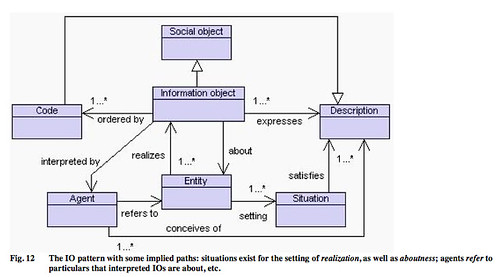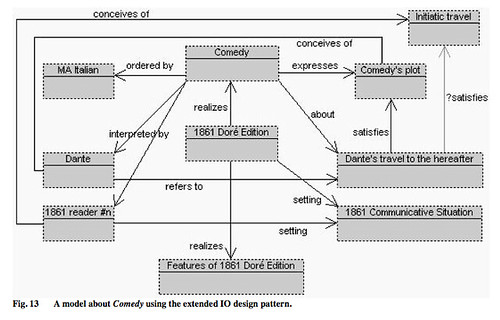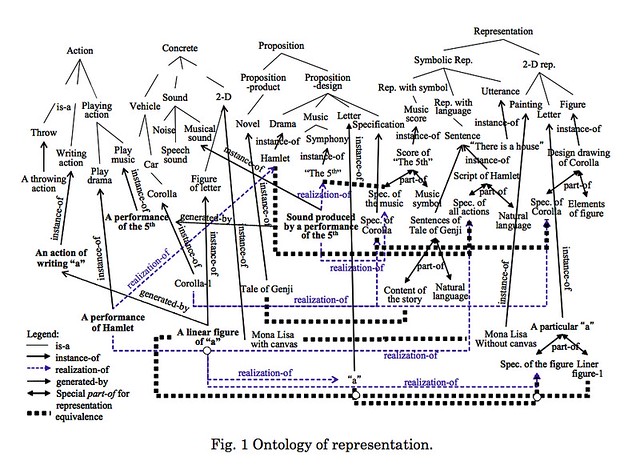Ontology of Representations
It's been three days that I'm struggling with concepts of content, form, representation and so on.. I wonder whether there's a well-formalized theory of representations out there.. the one in DOLCE is a useful design pattern, but I'm still reluctant to say that it is complete (I hope I'll find out to be wrong). Another clever view of the issue can be found in a tutorial by Richiiro Mizoguchi, and this is what this post is about.
In this tutorial Mizoguchi talks about representation - represented-thing - representational-form etc.. No mention of information-objects, which are instead (only as a term, maybe) always present everywhere else (Dolce, Cidoc, Cyc). So what's the proper mapping? Is an IO a representation? Moreover, I am trying to put also another model in the picture, FRBR. This bibliographic standard focuses around concepts such as work, expression and manifestation, mainly. So how do these come into the game?
Sometimes I end up in some sort of ontological relativism. Since the objects we study are essentially multidimensional, and since we humans can only rationally perceive a portion of such dimensions at a given time, it follows that whatever perspective we decide to take on our objects of investigation, it will be fundamentally arbitrary and partial. In other words, there is no chance of having a single unifying perspective on reality, one which can contain all the others. No chance. So every representation gives you one side of the story only - which can be related to other sides, but never in its entirety. If this is the case, we better keep all the possible 'sides' of this story, and just use the one we need whenever we need it. A pragmatist approach? Well.. more on this to come soon! (i'd also like to go back to Peirce, and check how all of this relates to his work)
Back to us: this is the model used in Dolce (more precisely, in the DnS module of Dolce, as described in Gangemi, A., Borgo, S., & Catenacci, C. (2005). Metokis deliverable D07 - Task Taxonomies for Knowledge Content. Deliverable of the EU FP6 project Metokis):
And this is an example of its instantiation:
The theory of Mizoguchi, as I said, it's quite different. Here's an interesting excerpt from the article Mizoguchi, R. (2004). Tutorial on ontological engineering - Part 3: Advanced course of ontological engineering. New Generation Computing, 22(2), 198–220.
A representation is composed of two parts, form and content.
Representation .......p/o "form": Representational form .......p/o"content": Proposition
where p/o stands for part-of relation/slot, “form” slot name and “: Representation” is a class constraint the slot value has to satisfy. Its identity is inherited from the form which is usually what people sense its existence. On the other hand, the content is the hidden part and it is a proposition which the author of the representation would like to convey through the representation. [...] It is critical to distinguish among proposition(content), representation and form of representation. In fact, although a novel is written in terms of sentences, novel is not a subclass of representation. What exists as a subclass of representation are what have the form of representation as its intrinsic property, that is, sentence, musical score, painting, etc. The sentences of Tale of Genji are instance-of sentence. However, representation and form of representation are different. Concerning a novel, representation is “sentence” which is composed of its content(novel) and “natural language” which is the syntactic part of the sentence, as the form of representation.
This is a quite impressive visual rendering of this ontological theory:
How are these theories different from each other? What are their pros and cons, where is it that they could be used more successfully? There's work to be done here..
Cite this blog post:
Comments via Github:
See also:
2013
New Technologies in Medieval and Renaissance Studies, (forthcoming). (part of the 'Envisioning REED in the Digital Age' collection)
2012
NeDiMaH workshop on ontology based annotation, held in conjunction with Digital Humanities 2012, Hamburg, Germany, Jul 2012.
2010
paper Review of Interontology conference 2010
Humana Mente, Journal of Philosophical Studies, 13, May 2010. Issue 13
2007
paper AquaLog: An ontology-driven question answering system for organizational semantic intranets
Journal of Web Semantics, Sep 2007. Vol. 5, 2, (72-105), Elsevier
2006
paper An ontology for the description and navigation through philosophical resources
European Conference on Philosophy and Computing (ECAP-06), Trondheim, Norway, Jun 2006.
2005
paper AquaLog A Ontology-portable Question Answering interface for the Semantic Web
2nd European Semantic Web Conference (ESWC05), Heraklion, Crete, Greece, May 2005. pp. 546-562


